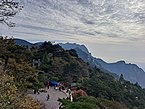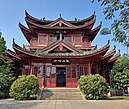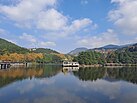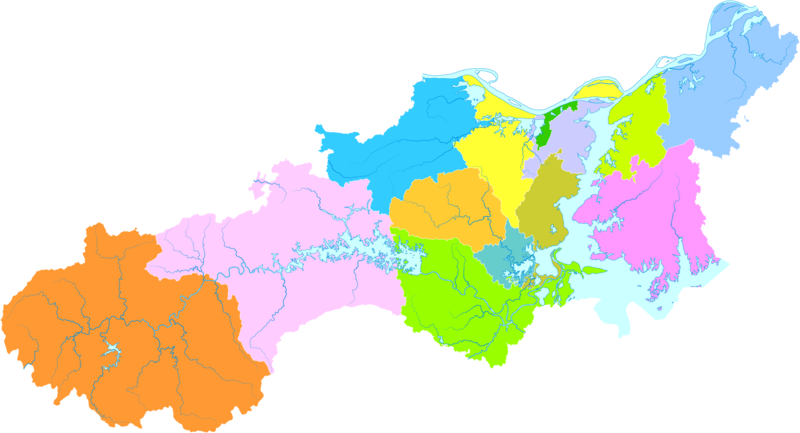Jiu gian g
Jiu gian g
Cửu Giang thị Kiukiang | |
|---|---|
Top to bottom, left to right:Jiu gian g Culture and Art Center, Pagoda of Suo gian g Pavilion, Jiu Jiang victory monument, looking at Wulaofeng from Mount Lushan's Pokou, Suo gian g pavilion, Bali Hunan lake, Ruqin lake | |
 Location of Jiu gian g City jurisdiction in Jiangxi | |
| Coordinates (Jiu gian g municipal government):29°39′40″N115°57′14″E/ 29.661°N 115.954°E | |
| Country | People's Republic of China |
| Province | Jiangxi |
| Seat | Municipal seat |
| Government | |
| •Party Secretary | Liu Wenhua |
| •Mayor | Yang Wenbin |
| Area | |
| •Prefecture-level city | 18,823 km2(7,268 sq mi) |
| • Urban | 598 km2(231 sq mi) |
| • Metro | 598 km2(231 sq mi) |
| Elevation | 20 m (70 ft) |
| Highest elevation | 1,794 m (5,886 ft) |
| Population (2020 census) | |
| •Prefecture-level city | 4,600,276 |
| • Density | 240/km2(630/sq mi) |
| •Urban | 2,814,240 |
| • Urban density | 4,700/km2(12,000/sq mi) |
| •Metro | 1,164,268 |
| • Metro density | 1,900/km2(5,000/sq mi) |
| GDP[2] | |
| •Prefecture-level city | CN¥190.3 billion US$30.5 billion |
| • Per capita | CN¥ 39,505 US$ 6,343 |
| Time zone | UTC+8(China Standard) |
| ISO 3166 code | CN-JX-04 |
| Website | www |
| Jiu gian g | |||||||||||||||||||||
|---|---|---|---|---|---|---|---|---|---|---|---|---|---|---|---|---|---|---|---|---|---|
| Chinese | Cửu Giang | ||||||||||||||||||||
| Postal | Kiukang | ||||||||||||||||||||
| Literal meaning | Nine Rivers | ||||||||||||||||||||
| |||||||||||||||||||||
Jiu gian g,formerly transliteratedKiukiangandKew-Keang,is aprefecture-level citylocated on the southern shores of theYangtze Riverin northwestJiangxi Provincein thePeople's Republic of China.It is the second-largest prefecture-level city in Jiangxi and its borders includePoyang Lake,the largest freshwaterlakein China. Jiu gian g is the fourth largest port on the Yangtze River[3][4]and was one of the first five cities that were opened to foreign trade along the Yangtze River following the implementation ofDeng Xiaoping'sOpening-Up Policy.It isJiangxi's only international trade port city.
Its population was 4,600,276 inhabitants at the2020 census,1,164,268 of whom resided in the built-up area (metro) made up of three urban districts (akaXunyang,Lianxi,andChaisang).[5]In 2007, the city was named China's top ten livable cities by the Chinese Cities Brand Value Report, which was released at 2007 Beijing Summit of China Cities Forum.[6]In 2022, the State Council of China granted Jiu gian g the title of Famed National Historical and Cultural City for its rich history and multiculture background in theRepublic of Chinaera.
Administrative divisions
[edit]
- Xunyang District(Tầm Dương khu)
- Lianxi District(Liêm khê khu)
- Chaisang District(Sài tang khu)
- Wuning County(Võ ninh huyện)
- Xiushui County(Tu thủy huyện)
- Yongxiu County(Vĩnh tu huyện)
- De'an County(Đức an huyện)
- Duchang County(Đều xương huyện)
- Hukou County(Hồ khẩu huyện)
- Pengze County(Bành trạch huyện)
- Ruichang(Thụy xương thị)
- Gongqingcheng(Cộng Thanh Thành thị). Directly administered as asub-prefecture-level citysince 1 July 2014.[7]
- Lushan(Lư Sơn thị)
- Others:
- Bureau and Administration Committees
- Mount Lu Scenic Area Administration Bureau
- Mount Lu West Sea Scenic Area Management Committee
- Bali Lake New Area Management Committee
- Poyang Lake Ecological Science and Technology City Management Committee
- Towns and Sub-district Offices
- There are 235 towns and 11 sub-district offices
| Map |
|---|
History
[edit]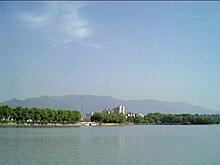
Ancient history
[edit]In ancient times it was told that nine rivers converged near where Jiu gian g sprang up to become Jiangxi's main water port today. From theXiato theShangdynasty, the capitals of several states were located in area of Jiu gian g.[citation needed]In theSpring and Autumn period(770–476 BCE) Jiu gian g bordered between the states ofWu(downstream, to the east) andChu(upstream, to the west).
Imperial history
[edit]Tao Yuanming(365–429 CE), a famous Chinese philosopher,recluseand poet, lived at the base ofMount Lu.He was once appointed magistrate of nearbyPengze Countyand after 83 days resigned owing to the politics involved in administering justice. He retired back to his village to pen an essay called "Peach Blossom Spring".In 757,Li Bai(701–762 CE) was implicated in theAn–Shi disturbancesand exiled at Jiu gian g.Bai Juyi(772–846 CE) wrote a poem called "Lute Song", which is about his sadness and isolation offorced exileas a middle rank official to reside in such a small and remote town. In the 13th centuryZhu Xiwas a Confucian philosopher who practiced at theWhite Deer Grotto Academy,on Mount Lu's eastern flanks.
Jiu gian g has also been known as Jiangzhou ( Giang Châu ) and Xunyang ( Tầm Dương ) in former times. During theJin dynasty (266–420)it was known as Sin Yang[citation needed],theLiang dynasty(502–557) ofSouthern and Northern Dynasties erait was called Jiangzhou. After reunification, theSui dynastysaw its name as Jiu gian g, and the Song dynasty (960–1127) called it Ting Jiang. TheMing dynasty(1368–1644), gave it Jiu gian g which has retained its name to this day. It was aTaiping rebellionstronghold for five years (1850–1864) after they[who?]devastated the town to only leave one street with buildings intact. The city served as the capital of Taiping's Jiangxi province during this time.
British concession and European settlement history
[edit]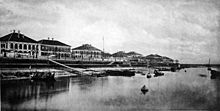
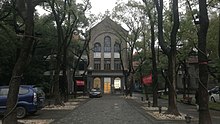

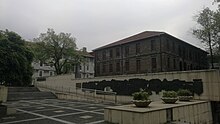

The arrival of the Europeans
[edit]A member ofLord Elgin's committee arriving in 1858 to survey Chinese ports for treaty status noted: "We found it to the last degree deplorable." A single dilapidated street, composed only of a few mean shops, was all that existed of this once thriving populous city. The remainder of the vast area composed within its massive walls 9–10 kilometers in circumference, contained nothing but ruins, weeds and kitchen gardens. After Jiu gian g becoming an open treaty port in 1862, it was exporting Jiangxi's vast rice crop. In 1904, more than 160,000 kilos of opium were moved through its customs house. The New York Methodist Mission Society's superintendent, Virgil C. Hart, arrived in Kiukiang in 1866 and bought a piece of property just east of the city wall. This is where the city's first Methodist church and Western hospital was built, with the hospital renamed the No. 1 Hospital, and the oldest/continuous operating hospital in Jiangxi Province.[8]In 1896 Drs.Mary Stone (Shi Meiyu)and Ida Kahn (Kahn Cheng) arrived back in Jiu gian g, being China's first two native female Western-educated doctors; having graduated from theUniversity of MichiganMedical School. They were provided with funds collected by Dr. I. N. Danforth (from Chicago residents), to build the Elizabeth Skelton Danforth Hospital and administered entirely by the native Chinese. This was later renamed Jiu gian g Women's and Children's Hospital, and the nursing education by Drs. Stone and Kahn would later be the impetus for the founding ofJiu gian g Universityand Jiu gian g Medical School.[9]
It became one of the three centers of the tea trade in China along withHankouandFuzhou.The Russians had two brick tea producing factories, but ceased operations after 1917. On October 16, 1927, there was an explosion of ammunition on the Chinese troopshipKuang Yuangnear Jiu gian g.[10]The British surrendered their concession in 1927 after being robbed and its Chinese workers mutineered their posts to the marauding crowds. An economic recession had set in over the decades as Indian and Chelonian tea made for greater competition. A military advance was being staged upriver in Wuhan by theKuomintangin 1927 and all the remaining expatriate community fled on British and American warships towards safer waters of Shanghai, to never return.[citation needed]Jiu gian g languished as a port and much of its export trade was siphoned off with the connecting ofNanchangto coastal rail lines built in 1936–37.
The establishment of the British concession
[edit]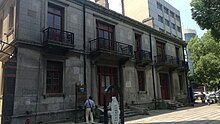
After China's defeat in the Second Opium War, China and Britain signed theTreaty of Tientsin.At the beginning of the eleventh year of Xianfeng (1861), the British counsellor,Harry Parkes,went to the new port on the Yangtse River by naval vessel according to the treaty to investigate the situation and select the site of concession to be opened. After the concession sites of Zhen gian g and Hankou were delimit, on March 22,Harry Parkesreturned to Jiu gian g from Hankou and decided to open up a commercial port in Jiu gian g.[11]
In the 11th year of xianfeng (1861), Zhang Jixin, general minister of Jiangxi province, signed with Harry Parkers the treaty of opening up the British concession in Jiu gian g, the Treaty of Land Lease in Jiu gian g. The concession was located in a narrow area on the west of Jiu gian g, between the Yangtze River and Gantang Lake, to the west of Longkai River, with a length of 150 zhang from east to west and a depth of 60 zhang from south to north, covering an area of 150 acres. The southern part of the concession includes part of PenPu Port.[12]
The development of Kuling in Mount Lu
[edit]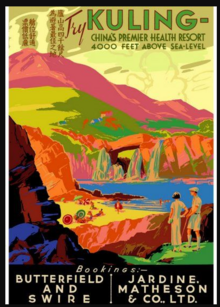
In the early 20th century,Kulingon top ofMount Lubecame the summer resort for international residents because of its beautiful geological landscape and nice climate. At the golden age, over 4000 foreigners from America and European countries lived in this small town in summer time.[13]
Kuling, on the slopes of a wide valley of Mount Lu, was established in 1895 by the missionariesEdward Selby Little,Dr. Edgerton Haskell Hartand three others, as a sanitarium and rest resort for Western missionaries in southern China. They built their houses in the colonial style of architecture, and added churches, schools, and sports facilities. It was named by Little, as a pun: it is wonderfullycoolingafter the summer heat in the plains below. It was also a word that sounded conveniently Chinese to the local people, and has been adopted by them. Kuling was run by the missionaries in a Kuling Council that sold the plots of the land and with the proceeds paid for local services and security. In 1910, Caroline Maddock Hart and four others met to found the Nurses Association of China; with Caroline Maddock Hart being its first president.

Modern history
[edit]In 1938, Jiu gian g was occupied by Japanese forces during theWuhan campaign.Following its capture, the city was the site of a "mini-Nanjing Massacre,"where male residents were executed and women raped.[14]Many of the city's urban districts and suburban villages were razed, including the city's ceramics factories and boats used for transportation.[15]
Until 1949 Jiu gian g had very little industry except for local handicrafts. Manufacturing is Jiu gian g's backbone today with auto, machinery, petrochemical, shipbuilding and textiles as its cornerstones. After the completion of theYangtze River Bridgein 1992 and theBeijing to Kowloon (Hong Kong)and Wuhan to Shanghai rail systems laid, a convenient ground corridor was provided and a regional airport now serves most of China's capital cities.
In 2005, an earthquake hitRuichang.Kuling American School Associationdonated 200 sets of desks and chairs and more than 50 sets of Oxford English-Chinese Dictionary to a local primary school near Ruichang.[16][17]
Economy
[edit]Economic and Technological Development Zones
[edit]Latest Ranking in the Chinese Cities
[edit]In 2021, Jiu gian g's GDP is 373.528 Billion Yuan. Jiu gian g's GDP ranks 70th among all Chinese cities.[21]
Demography
[edit]The city administers a total population of approximately 4,600,276 at the 2020 census of whom approximately 2,814,240 are urban living in the urban area.[5]The population density is 240 per km2.Han Chinesemake up 99.8% of the population. Registered residents include 25 ethnic minorities. Six of them are major minorities in Jiu gian g. They are:Hui,Miao,Zhuang,Tujia,andShe.
Jiu gian g dialect is unlike typicalGandialect of Jiangxi. Jiu gian g dialect is a variety ofLower Yangtze Mandarinand is close to Wu languages.[22]
Climate
[edit]Jiu gian g ahumid subtropical climate(KöppenCfa). Extremes since 1951 have ranged from as low as −6.7 °C (19.9 °F) (though an unofficially has reached as low as −10 °C (14.0 °F) on 10 January 1931)[23]to as high as 40.9 °C (105.6 °F).
| Climate data for Jiu gian g (1991–2014 normals, extremes 1981–2010) | |||||||||||||
|---|---|---|---|---|---|---|---|---|---|---|---|---|---|
| Month | Jan | Feb | Mar | Apr | May | Jun | Jul | Aug | Sep | Oct | Nov | Dec | Year |
| Record high °C (°F) | 21.3 (70.3) |
29.1 (84.4) |
31.8 (89.2) |
34.1 (93.4) |
37.0 (98.6) |
38.6 (101.5) |
40.9 (105.6) |
40.9 (105.6) |
38.9 (102.0) |
35.6 (96.1) |
29.7 (85.5) |
22.8 (73.0) |
40.9 (105.6) |
| Mean daily maximum °C (°F) | 8.0 (46.4) |
11.0 (51.8) |
15.5 (59.9) |
22.1 (71.8) |
27.1 (80.8) |
29.8 (85.6) |
33.7 (92.7) |
32.6 (90.7) |
28.7 (83.7) |
23.5 (74.3) |
17.2 (63.0) |
10.9 (51.6) |
21.7 (71.0) |
| Daily mean °C (°F) | 4.9 (40.8) |
7.5 (45.5) |
11.5 (52.7) |
17.8 (64.0) |
22.8 (73.0) |
26.1 (79.0) |
29.8 (85.6) |
28.7 (83.7) |
24.8 (76.6) |
19.6 (67.3) |
13.3 (55.9) |
7.3 (45.1) |
17.8 (64.1) |
| Mean daily minimum °C (°F) | 2.6 (36.7) |
5.0 (41.0) |
8.6 (47.5) |
14.5 (58.1) |
19.5 (67.1) |
23.3 (73.9) |
26.7 (80.1) |
25.9 (78.6) |
22.1 (71.8) |
16.7 (62.1) |
10.4 (50.7) |
4.8 (40.6) |
15.0 (59.0) |
| Record low °C (°F) | −4.2 (24.4) |
−5.3 (22.5) |
−1.0 (30.2) |
3.6 (38.5) |
10.0 (50.0) |
14.5 (58.1) |
19.8 (67.6) |
17.8 (64.0) |
14.3 (57.7) |
5.6 (42.1) |
−0.7 (30.7) |
−6.7 (19.9) |
−6.7 (19.9) |
| Averageprecipitationmm (inches) | 80.7 (3.18) |
99.2 (3.91) |
147.6 (5.81) |
166.6 (6.56) |
186.0 (7.32) |
229.3 (9.03) |
170.0 (6.69) |
123.3 (4.85) |
74.3 (2.93) |
73.5 (2.89) |
73.5 (2.89) |
54.0 (2.13) |
1,478 (58.19) |
| Average precipitation days(≥ 0.1 mm) | 12.6 | 12.4 | 15.9 | 14.5 | 13.9 | 14.1 | 10.7 | 11.2 | 8.1 | 8.5 | 10.3 | 9.4 | 141.6 |
| Average snowy days | 3.6 | 2.2 | 0.6 | 0 | 0 | 0 | 0 | 0 | 0 | 0 | 0.1 | 1.5 | 8 |
| Averagerelative humidity(%) | 76 | 75 | 75 | 74 | 74 | 79 | 74 | 77 | 76 | 72 | 74 | 72 | 75 |
| Mean monthlysunshine hours | 86.0 | 90.3 | 109.6 | 135.3 | 148.8 | 133.9 | 197.0 | 188.7 | 158.0 | 152.5 | 124.4 | 113.0 | 1,637.5 |
| Percentpossible sunshine | 26 | 29 | 29 | 35 | 35 | 32 | 46 | 47 | 43 | 43 | 39 | 36 | 37 |
| Source:China Meteorological Administration[24][25] | |||||||||||||
Industry
[edit]Primary industries and tertiary sector include:[26]
- Manufacturing
- Petrochemical Refinement
- Tourism
- Import/Export (through river port)
- Agricultural Chemical Production
Transport
[edit]Road
[edit]Source:[27]
- G56 Hangzhou–Ruili Expressway
- G70 Fuzhou–Yinchuan Expressway
- Jiu gian g Ring Expressway
- Chang-Jiu Expressway
- Jiu-Rui Expressway
- G45 Daguang Expressway
- Yongwu Expressway
- Penghu Expressway
- Xiu-ping Expressway
- Du-Jiu Expressway
- Dong-jiu Expressway
Rail
[edit]- Beijing-Kowloon
- Tongling–Jiu gian g
- Hefei–Jiu gian g
- Wuhan–Jiu gian g
- Nanchang–Jiu gian g Intercity Railway
- Chang-jiu intercity railway
- Wu-jiu high speed railway
- Jiujing-qu railway
- He-an-Jiu passenger dedicated line
- Fu-gang-jiu passenger dedicated line
- Chang-jiu high speed railway.
Air
[edit]Port
[edit]Jiu gian g Port is the largest port in Jiangxi Province located at the junction of the Yangtze River, Poyang Lake and the Beijing-Kowloon Railway. From west to east, this port consists of five docks namely Ruichang, Chengxi, Chengqu, Hukou and Pengze. As an important port situated on the lower and middle reaches of Yangtze River and one of the 5 main ports on the river, many domestic and international marine routes have been established, In the main, the freight handled consists of mineral building materials, coals, metal and nonmetal ores and petroleum. [30]
Yangtze Bridges
[edit]At present, Jiu gian g has two Bridges built across the Yangtze River. They areJiu gian g Yangtze River BridgeandJiu gian g Yangtze River Expressway Bridge.The third bridge across the Yangtze River in Jiu gian g is under construction. The fourth bridge across the Yangtze River in Jiu gian g is being designed [31] [32]
Colleges and universities
[edit]
- University of Jiu gian g:a university located inLianxi District.The location is most easily reached by the 101 bus from the city center.[33]
- Jiangxi Vocational College of Finance and Economics:a small picturesque college located right by the lake. This college is well situated within the city.[34]
- Jiu gian g Vocational and Technical College:a vocational college located inLianxi DistrictnearUniversity of Jiu gian g.[35]
- Jiu gian g Vocational University:a vocational college located inLianxi DistrictnearUniversity of Jiu gian g.[36]
- Jiangxi Fenglin College:a vocational college located in Yongxiu county. Yongxiu county belongs to Jiu gian g.[37]
- Jiu gian g Vocational College of Polytechnic:a vocational college located in Jiu gian g Economic and Technological Development Zone.[38]
- Gongqing Institute of Science and Technology:a vocational college located inGongqingcheng.Gongqingcheng belongs to Jiu gian g.[39]
- Gongqing College of Nanchang University:a local college located in Gongqingcheng.[40]
- Science and Technology College of Jiangxi Normal University:a local college located in Gongqingcheng.[41]
- Modern Economics and Management College of Jiangxi Finance and Economics University:a local college located in Gongqingcheng.[42]
- Science and Technology College of Nanchang Aviation University:a vocational college located in Gongqingcheng.[43]
- Science and Technology College of Nanchang University:a local college located in Gongqingcheng.[44]
- Nanchang Business College of Jiangxi Agriculture University:a local vocational college located in Gongqingcheng.[45]
International relations
[edit]Former Diplomatic Representatives in Jiu gian g
[edit]- British Consulate General Jiu gian gwas established in 1861
- Japanese Consulate General Jiu gian gwas established on July 16, 1915
Twin towns — Sister cities
[edit]Jiu gian g istwinnedwith: [46]
Tourism
[edit]
- Mount Lu:one of the most famous mountains in China. It is located in the south of the urban center and listed as aWorld Heritage Site.[47]
- Mount Lu Geopark:is located on Mount Lu. In 1996, Mount Lu became a UNESCOWorld Heritage Site.In 2004, the Mount Lu Geopark became a member ofGlobal Geoparks Network.Mount Lu Geopark is a place of striking beauty. It has spectacular peaks, lakes, cliffs, waterfalls and important Buddhist and Taoist temples.[48]
- Kuling:as a homonym for cooling. It is a mountain town in the Mount Lu National Park. It was established in 1895 by the missionariesEdward Selby Little,Dr.Edgerton Haskell Hartand three others, as a sanitarium and summer resort for Western missionaries in southern China.[49]
- British Concession Museum:located on Bin gian g road. It was established by local government from transforming buildings left from the formerBritish Concession of Jiu gian g.[50][circular reference]
- Yuliang South Road Historical and Cultural Block:a street combines Chinese and Western cultures. Beside the street are:[51]
- the old Catholic school
- the old monastery
- the Catholic church
- Taling Park
- the old Perkins Villa
- Nengren temple
- Western Goods Exhibition Window
- Lushan Hotspring:located in Hotspring town,Lushan City.Lushan Cityis a county-level city belong to Jiu gian g.[52]
- Haiyun Sand Beach:located in Balihu Park. It is the only high standard man-made beach inJiangxiProvince. It is a famous scenic spot and entertainment resort in Jiu gian g.[53]
- Xunyang River Scenic Area:located on Bin gian g Road inXunyang District.It is near shoreline of the Yangtze River. Covering an area of some 765 acres (around 509,490 sqm), with distance of 5.2 km long from east to west. It is only 4.5 km away from Jiu gian g Station, 1.6 km away from Fuzhou-Yinchuan Expressway, and about an hour's drive from Changbei Airport. Its rich tourism resources include river, ancient building, garden and museum as follows:[54]
- Pipa Pavilion
- Xunyang Tower
- Suo gian g Pagoda
- British Concession Museum
- Baishui Lake Park
- Xunyang River Cruise Ship
- Mount Lu West Sea:is located about 90 kilometers to the south of Mount Lu. It is National 5-Star Scenic Spot. There are thousands of islands in the area just like Maldives. In 2007, between June and August, American reality program Survivor filmed its fifteenth season,Survivor: China,in the area. The program host Jeff Probst claimed that this was the first American television series filmed entirely in China.[55]
- Nanshan Park (Nam Sơn công viên): completed in early 2013. This park, home to a new pagoda, is covered in flora and lights up the Jiu gian g sky at night.[56]
- Yanshui Pavilion: located in city center, near Gantang lake. It is a well known scenic spot in Jiu gian g.[57]
- Donglin Temple:a Buddhist temple located at foot of Mount Lu. It is built byHuiyuan (Buddhist),founder ofPure Land Buddhism.Pure Land Buddhism later spread to Japan and gained its prominence there. In 1175,Hōnenestablished Pure Land Buddhism as an independent sect in Japan known asJōdo-shū.Pure Land schools have nearly 40 percent of Japanese Buddhism practitioners, only second toChanschools.[58][59]
- The temple provide free vegetarian lunch and free guest house. Visitors can stay at guest house in temple for free up to three days. The guest house is gender separated, and visitors have to share room with others.[59]
- Donglin Buddha:the world's tallest statue ofAmitabha Buddha.Total cost is about 1 billion Yuan. Surface of the Buddha is plated with 48 kilograms of gold. Buddha height is 48 meters tall, representing the forty-eighth vows of Amitabha Buddha. Total height is 81 meters.[60][61]
- Mount Lu Four Seasons Flower City (Botanical Garden): located in Bali lake New Area. It is Jiu gian g's largest flower plant park.[62]
- Stone Bell Hill: just downriver from Jiu gian g is Hukou where the Yangtze River and waters of Boyang Lake converge with an abrupt color change. People have been coming here for centuries to listen to the stone-bell sound resonating from the cliffs overlooking this spot. A few theories are provided why this rare geographical phenomenon happens. Li Daoyuan from the Northern Wei period (386–534) theorizes that it is because the hill has a bell-shaped appearance and hollow inside, thus providing the sound when struck. Or it may be because of the water lapping within the limestone nooks and fissures around its base, as famous litterateur from the same time Su Shui discovered. Su Dongpo also did three trips around its perimeter, before settling on this last explanation for its unique sound also. Many Chinese literati's have left more than twenty calligraphy masterpieces carved upon its rocks, with some dating back to the Tang dynasty (618–907 CE).[63]
Notable residents
[edit]- Mary Stone (Shi Meiyu)(1873–1954), one of the first western trained Chinese female physicians. Founder of Elizabeth Skelton Danforth Hospital (now called Jiu gian g Women and Children's Hospital) in Jiu gian g.[64][65]
- Lo-Yi Chang (1907–1988), was born inKuling,Mount Lu.She was spouse ofT.V. Soong,then Premier of the Republic of China. She has made a significant contribution to the promotion of China overseas.[66]
- Pearl S. Buck(1892–1973), was the first American woman won Nobel Prize in Literature, for her rich and truly epic descriptions of peasant life in China, in 1938. She also won Pulitzer Prize in 1932. She spent her childhood with her family inKulingin summer time. Her father built a stone villa in Kuling in 1897, and lived there until his death in 1931.[67][68]
- Masato Matsuura( tùng phổ chính nhân ) (1942– ), born in Jiu gian g. He was a Japanese politician. He served asHōfumayor and president of National Mayors Association of Japan.[69][70]In 2018, thenHōfumayor and president of National Mayors Association of Japan (NMAJ), Masato Matsuura ( tùng phổ chính nhân ), led a delegation of NMAJ visitedformer Japanese consulate of Jiu gian g.Masato Matsuura said:I was born in the former Japanese consulate of Jiu gian g. Jiu gian g is my second hometown. I am deeply attached to the beautiful landscape here.[71]
- Chiang Yee(1903–1977), born in Jiu gian g. He was a Chinese poet, author, painter and calligrapher. His translation ofCoca Colais remembered by all Chinese.[72]
- Mervyn Peake(1911–1968), born inKuling,Mount Lu.He was an English writer, artist, poet, and illustrator. He was well known for being the illustrator ofAlice's Adventures in Wonderland.[73]
- Maggie Mac Neil(2000- ), born in Jiu gian g and adopted to Canada at an early age[74]
- Sylvia Wu(1915–2022), born in Kiukiang and later became a Los Angeles restaurateur and a writer.
- Ilien Tang(died 1920), Methodist missionary educator born in Jiu gian g[75]
See also
[edit]References
[edit]- ^Địa lý giao thông[Geography and transport] (in Simplified Chinese). Jiu gian g People's Government. Archived fromthe originalon 18 November 2019.Retrieved1 June2018.
- ^Giang Tây tỉnh thống kê cục, quốc gia thống kê cục Giang Tây điều tra tổng đội (August 2016).《 Giang Tây thống kê niêm giám -2016》.Trung Quốc thống kê nhà xuất bản.ISBN978-7-5037-7809-4.Archived fromthe originalon 2018-05-11.Retrieved2017-06-05.
- ^"Cải cách mở ra 40 năm: Cửu Giang cảng trở thành danh xứng với thực" trăm triệu tấn đại cảng "".Jiu gian g News Network.Retrieved22 July2021.
- ^""Trăm năm lão cảng" Giang Tây Cửu Giang cảng củng cố trăm triệu tấn đại cảng địa vị ".Sohu.Retrieved22 July2021.
- ^ab"Cửu Giang thị thứ bảy thứ cả nước dân cư tổng điều tra công báo"(PDF).Jiu gian g Statistics Bureau Website.Archived fromthe original(PDF)on 3 November 2021.Retrieved22 July2021.
- ^"China's Top 10 Most Livable Cities".hnloudi.gov.cn.Hunan Loudi Official Government. 2012-03-28. Archived fromthe originalon 2013-04-10.Retrieved2014-08-04.
- ^Cộng Thanh Thành thị bị xếp vào tỉnh thẳng quản huyện cải cách thí điểm(in Simplified Chinese).People.cn.29 May 2014. Archived fromthe originalon 12 June 2018.Retrieved7 June2018.
- ^"Man On A Mission" by Stanley Crawford
- ^"The Middle Kingdom's Miracle Maidens" by Stanley Crawford
- ^"1,200 Die as Yangtse Troopship Blows Up".The New York Times.October 17, 1926.
- ^Bickers, R., & Jackson, I. (2016). Introduction: law, land and power: treaty ports and concessions in modern China. In Treaty Ports in Modern China (pp. 11–32). Routledge.
- ^Bickers, R. (2013). 8. British Concessions and Chinese Cities, 1910s–1930s. In New Narratives of Urban Space in Republican Chinese Cities (pp. 155–195). Brill.
- ^Nield, R. (2015). China’s Foreign Places: The Foreign Presence in China in the Treaty Port Era, 1840–1943. Hong Kong University Press.
- ^Mitter, Rana (2013).Forgotten Ally: China's World War II, 1937-1945.Houghton Mifflin Harcourt. p. 165.
- ^Harmsen, Peter (2018).Storm Clouds Over the Pacific, 1931–1941 (War in the Far East).Casemate. pp. 150–151.
- ^"Cổ lĩnh chi phù trường học ngoại tịch bạn cùng trường xa cách 60 nhiều năm trọng du Lư Sơn".Jiu gian g News Network.Retrieved22 July2021.
- ^"Kuling American School Association nước Mỹ học đường".Kuling American School Association Website.Retrieved22 July2021.
- ^"Cửu Giang tổng hợp bảo lưu thuế nhập khẩu khu".Jiu gian g Free Trade Zone Website.Archived fromthe originalon 20 July 2021.Retrieved20 July2021.
- ^"Cửu Giang quốc gia cấp kinh tế kỹ thuật khai phá khu".Jiu gian g National Economical and Technological Development Zone Website.Archived fromthe originalon 22 July 2021.Retrieved20 July2021.
- ^"Cửu Giang cộng Thanh Thành quốc gia cao tân kỹ thuật sản nghiệp khai phá khu".Jiu gian g Gongqingcheng National High-tech Industrial Development Zone.Archived fromthe originalon 20 July 2021.Retrieved20 July2021.
- ^"2021 năm Trung Quốc thành thị GDP trăm cường bảng".tencent.Retrieved22 July2021.
- ^Lin, Xianlian (2019-03-26)."zh: Cửu Giang phương ngôn kiếp trước kiếp này"[The Past and Present Life of Jiu gian g Dialect].zgdazxw.cn(in Chinese).Retrieved2024-06-08.
- ^Võng dễ (2018-12-08)."Hai ngày này căn bản không tính lãnh nhìn xem cả nước các thành phố lớn lịch sử cực đoan thấp nhất độ ấm là mấy độ?".163.Retrieved2024-09-16.
- ^Trung Quốc khí tượng số liệu võng – WeatherBk Data(in Simplified Chinese).China Meteorological Administration.Retrieved28 June2023.
- ^ "Experience Template"Trung Quốc khí tượng số liệu võng(in Simplified Chinese).China Meteorological Administration.Retrieved28 June2023.
- ^"Sản nghiệp".Jiu gian g People's Government Website.Archived fromthe originalon 21 July 2021.Retrieved21 July2021.
- ^"Quốc lộ".Jiu gian g Government Website.Archived fromthe originalon 21 July 2021.Retrieved22 July2021.
- ^"Đường sắt".Jiu gian g Government Website.Archived fromthe originalon 21 July 2021.Retrieved22 July2021.
- ^"Sân bay".Jiu gian g Government Website.Archived fromthe originalon 21 July 2021.Retrieved22 July2021.
- ^"Cảng".Jiu gian g Government Website.Archived fromthe originalon 21 July 2021.Retrieved22 July2021.
- ^"Đại kiều".Jiu gian g Government Website.Archived fromthe originalon 21 July 2021.Retrieved22 July2021.
- ^"Cửu Giang Trường Giang đại kiều".China-qiao.Retrieved23 July2021.
- ^"Cửu Giang học viện".Jiu gian g University Website.Retrieved19 July2021.
- ^"Giang Tây kinh tế tài chính chức nghiệp học viện".Jiangxi Vocational College of Finance & Economics Website.Archived fromthe originalon 19 July 2021.Retrieved19 July2021.
- ^"Cửu Giang chức nghiệp kỹ thuật học viện".Jiu gian g Vocational and Technical College Website.
- ^"Cửu Giang chức nghiệp đại học".Jiu gian g Vocational University Website.Archived fromthe originalon 19 July 2021.Retrieved19 July2021.
- ^"Giang Tây rừng phong ngoại giao kinh mậu chức nghiệp học viện".Jiangxi Fenglin College of Foreign Economy & Trade Website.Archived fromthe originalon 27 January 2021.Retrieved19 July2021.
- ^"Cửu Giang lý công chức nghiệp kỹ thuật học viện".Jiu gian g Vocational College of Polytechnic Website.Retrieved19 July2021.
- ^"Cộng thanh chức nghiệp kỹ thuật học viện".Gongqing Institute of Science and Technology Website.Retrieved20 July2021.
- ^"Nam Xương đại học cộng thanh học viện".Gongqing College of Nanchang Website.Retrieved20 July2021.
- ^"Giang Tây đại học sư phạm khoa học kỹ thuật học viện".Science and Technology College of Jiangxi Normal University.Retrieved20 July2021.
- ^"Giang Tây kinh tế tài chính đại học hiện đại kinh tế quản lý học viện".Modern Economics and Management College of Jiangxi Finance and Economics University Website.Retrieved20 July2021.
- ^"Nam Xương hàng không đại học khoa học kỹ thuật học viện".Science and Technology College of Nanchang Aviation University Website.Retrieved20 July2021.
- ^"Nam Xương đại học cộng thanh học viện".Science and Technology College of Nanchang University Website.Retrieved20 July2021.
- ^"Giang Tây nông nghiệp đại học Nam Xương thương học viện".Nanchang Business College of Jiangxi Agriculture University Website.Retrieved20 July2021.
- ^"Sister Cities".jiu gian g.gov.cn.Jiu gian g. Archived fromthe originalon 2020-07-14.Retrieved2020-07-12.
- ^"Mount Lu Scenic Area".Trip.Retrieved19 July2021.
- ^"Mt. Lushan National Park".Tripadvisory.Retrieved20 July2021.
- ^Winnington, G. Peter; Stauber, Max (2006)."Kuling, Peake's Birthplace".Peake Studies.9(4): 9–22.JSTOR24776512.Retrieved20 July2021.
- ^British Concession in Jiu gian g
- ^"Xunyang District" 13th Five-Year "Historical and Cultural Block Construction Documentation".Xunyang People's Government Website.Archived fromthe originalon 19 July 2021.Retrieved19 July2021.
- ^"Lushan Hot Spring – Jiu gian g".Visit Our China.Retrieved19 July2021.
- ^"Haiyun Sand Beach".Trip.Retrieved19 July2021.
- ^"Xunyang River Scenic Area".Xunyang River Scenic Area Website.Retrieved19 July2021.
- ^"Lư Sơn Tây Hải".Mountain Lu West Sea Website.Archived fromthe originalon 2021-07-21.Retrieved2021-07-21.
- ^"Nanshan Park".Trip.Retrieved19 July2021.
- ^"Yanshui Pavilion".Tripadvisor.Retrieved19 July2021.
- ^"Donglin Temple".Trip.Retrieved19 July2021.
- ^ab"Đông lâm tổ đình".Donglin Temple Website.Retrieved20 July2021.
- ^"Donglin Buddha".Trip.Retrieved20 July2021.
- ^"Đông lâm đại Phật".Donglin Temple Website.Retrieved20 July2021.
- ^"Cửu Giang bốn mùa hoa thành".Jiu gian g News Network.Retrieved20 July2021.
- ^"Stone Bell HIll (Shizhong shan)".tripadvisor.Retrieved19 July2021.
- ^Tobin, James."The New Women of China".Medicine at Michigan, Fall'10, Volume 12, Number 3.University of Michigan.Archivedfrom the original on 28 March 2016.Retrieved15 February2014.
- ^"Shi Meiyu (Mary Stone) |".Archivedfrom the original on 2020-04-28.Retrieved2020-04-27.
- ^Trì hân hồng (22 July 2015)."Quốc nội danh nhân truyện ký bộ sách ( trang phục cộng 6 sách )".books.google.Retrieved22 July2021.
- ^"Tái triệu tường mộ bia".mylushan.Retrieved22 July2021.
- ^"Pearl S. Buck house in Zhen gian g".Retrieved22 July2021.
- ^"Tùng phổ chính nhân".ZHZ.wiki.Retrieved22 July2021.
- ^"7/30 Nhật Bản cả nước thị trưởng gặp trường tùng phổ chính nhân mặc cho chúc mừng sẽ".Fukuoka Branch, Taipei Economic and Cultural Office in Osaka Website.Retrieved22 July2021.
- ^"Nhật Bản cả nước thị trưởng sẽ đoàn đại biểu tới chơi Cửu Giang Tô Giới địa chỉ cũ".Jiu gian g Cultural and Tourism Development Group Website.Retrieved21 July2021.
- ^Huang, Shuchen S., "Chiang Yee", inAsian-American Autobiographers: a bio-bibliographical critical sourcebook,edited by Guiyou Huang, Greenwood Press, 2001.ISBN0-313-31408-X.
- ^Carroll, Lewis (12 October 2001).Alice's Adventures in Wonderland.Bloomsbury Publishing USA.ISBN1582341745.
- ^Tang, Didi (2021-07-27)."Maggie Mac Neil's Olympic gold for Canada thrusts China's one-child policy back into spotlight".The Times.Retrieved2021-08-01.
- ^Honsinger, Welthy B.,"Ilien Tang"Woman's Missionary Friend52(20)(August 1920): 285.




